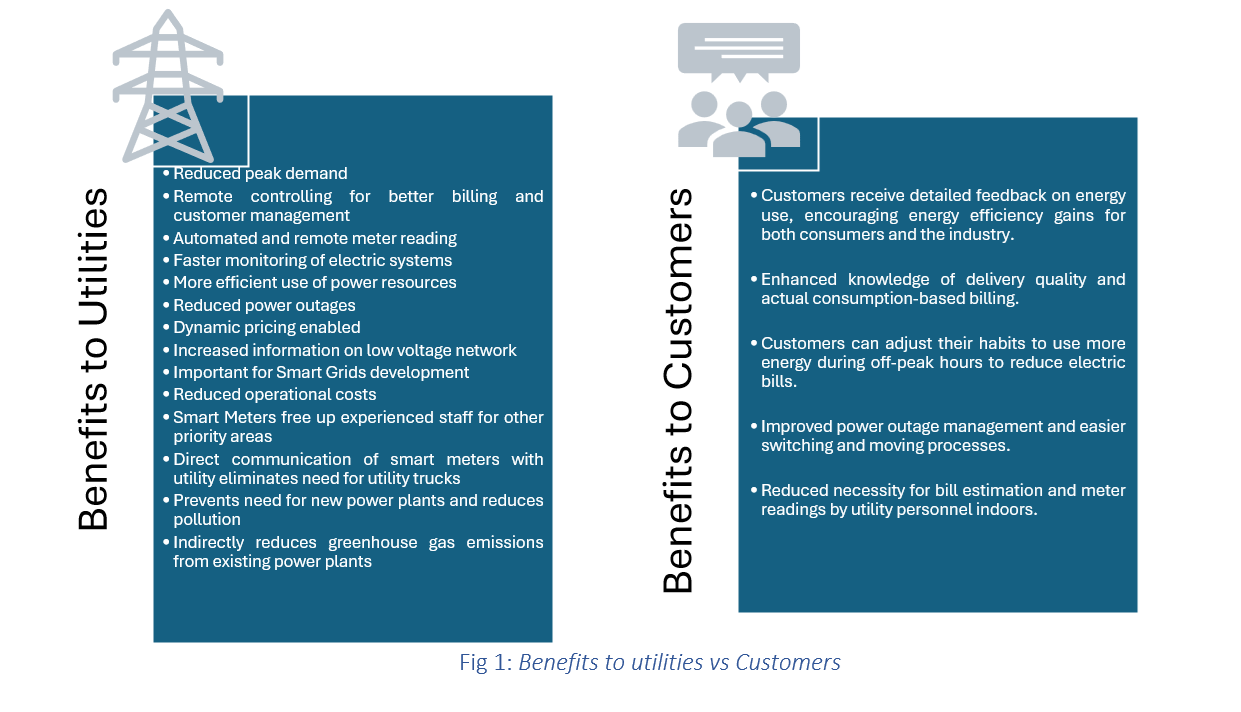Realizing the Potential of Smart Metering Solutions in Advanced Metering Infrastructure
Introduction
Smart meter deployments have rapidly increased worldwide, driven by utility companies’ need for more accurate and timely data. When considering connectivity decisions for these smart meters, companies must evaluate cost, coverage, security, power usage, and potential throughput. How do these factors influence the deployment process? By using smart meters, distribution companies receive immediate notifications in case of any power load changes. These meters allow companies to disconnect and reconnect remotely and track power quality. Since these meters are bi-directional, consumers generating solar power at home don’t require new meters. Additionally, from a cybersecurity standpoint, smart meters use sophisticated encryption.
Did you know the AMI investment is projected to reach USD 127.6 billion by 2025, with nearly 1.3 billion smart meters deployed over the same period? For instance, India’s commitment to enhancing smart metering infrastructure is evident through Singapore’s USD 2 billion investment in Genus Power’s platform, which will support India’s National Smart Metering Project’s 250 million meters by 2025.
Advanced Metering Infrastructure (AMI) represents a key advancement in energy management, utilizing smart meters to enhance efficiency, reliability, and sustainability. AMI encompasses data collection, communication, management, and customer interaction. So, what benefits does AMI bring to both utilities and consumers? It improves demand forecasting, integrates renewable energy sources, and implements dynamic pricing models. AMI offers real-time consumption data, remote reading, two-way communication, outage detection, and enhanced security features.
This blog outlines the importance of choosing the proper connectivity for smart meter deployments and the challenges faced by the energy sector while implementing these solutions. Additionally, we will discuss the functions and requirements of smart meters deployed by utilities, including various drivers, advantages, and associated challenges. Most meter data and billing solutions offer standard functionality but can be tailored to utility requirements. Time-of-use and bi-directional communication are highlighted as top functionalities benefiting both customers and utilities, potentially improving power supply management.
But first, let’s check out the key stages of smart meter functionality:
Data gathering and sending back to utilities: Smart metering systems installed at customers’ locations automatically measure consumption and periodically report results to utilities.
Receiving and managing data: All data from installed smart meters is centralized at the AMI head-end system. After verification and initial processing, the system sends the information to the meter data management system (MDMS).
Data analysis and processing: Utilities can use the significant information produced to make well-informed decisions about various aspects, including distribution automation, demand response, and load forecasting. For example, how can power providers use AMI to control transformer loads during and after a blackout? By using data from smart meters.
Customer-server relationship: Utilities benefit from data processing and analysis, as do their customers. Once the utility has all the required data insights, customers can access comprehensive energy usage information on demand through customer portals and in-home displays. This transparency can influence consumer choices, promote energy-saving actions, and improve customers’ ability to control their energy expenses.
Notifying and managing outages: Smart metering systems provide outage management tools that can send a last gasp signal to affected smart meters before the power goes off in the case of an impending outage. This function aids utility companies in swiftly locating and resolving problems.
Strategic view on installing smart metering
Various elements are involved in realizing the actual advantages of installing smart meters as part of implementing AMI solutions. The question is, what drives the implementation of smart meters? The major driving factor is increased efficiency. Smart metering systems provide utilities and consumers with more information, encouraging reduced energy use. Moreover, the need for increased billing accuracy drives smart metering. Businesses have been compelled to implement smart metering to reduce losses resulting from fraud.
The development of smart grids is an increasingly crucial component of smart metering deployment. Smart meters are essential in enabling distributed generation and integrating renewable energy sources into the grid. What benefits can both utilities and customers gain from smart metering solutions? Let us find out below.

Fig 1: Benefits to utilities vs Customers
Addressing challenges and limitations
Deploying AMI offers many advantages but also presents drawbacks, such as large upfront costs, integration with other grid systems, and standardization.
- Cost: Full implementation of AMI requires investments in hardware and software components, such as meters, network infrastructure, and network management software, with additional costs for installing and maintaining information technology systems and meters.\
- Integration: Customer Information Systems, Geographic Information Systems, Outage Management Systems, Work Management, Mobile Workforce Management, Supervisory Control and Data Acquisition/Data Management System (SCADDA/DMS), Distribution Automation System, and other utility confirmation technology systems must be integrated with AMI.
- Standardization: Interoperability standards that establish consistent requirements for AMI deployment and general operations are necessary for proper connection and management.
Competitive advantages for utilities
Utilities have gained several competitive advantages from effectively implementing smart metering technology, resulting in increased customer satisfaction, operational efficiency, and successful integration of renewable energy sources. Here are a few success stories that illustrate these advantages:
Success stories
- Enel: This Italian utility pioneered smart metering technology, installing over 30 million meters. This led to operational efficiency, improved outage management, and enhanced customer engagement. Enel’s investment in Genus Power’s smart metering platform is expected to boost operations further.
- PG&E: Deployed millions of smart meters across California, implementing a comprehensive AMI project that offered competitive advantages such as demand response programs, personalized energy-saving tips, and regulatory compliance. This data-driven approach stabilized the grid, reduced costs, and improved customer satisfaction.
- British Gas: Implemented smart meters in millions of homes and businesses in the UK, offered competitive advantages such as customer empowerment, operational savings, and renewable integration. The system monitors real-time energy usage, reduces manual meter readings, and improves billing accuracy.
- TEPCO: Installed millions of smart meters in Tokyo to improve disaster management, energy conservation, and enhance analytics. These meters provided critical data for power restoration, encouraged off-peak usage, and helped Tokyo Electric Power Company (TEPCO) plan future infrastructure investments more efficiently.
These utilities demonstrate that smart metering technologies offer significant competitive advantages, such as increased consumer engagement, cost savings, and greater integration of renewable energy. These advantages contribute to making energy infrastructure more resilient and sustainable.
Our perspective on implementing smart metering
Smart meters provide real-time energy usage data, enabling consumers to monitor consumption patterns, adjust behaviors, reduce costs, and facilitate grid modernization by integrating renewable energy sources like solar and wind. However, several criticisms and challenges may arise with the installation of smart meters. Privacy concerns, such as data security and consumer trust, are raised due to detailed energy usage data collection. High initial costs, potential return on investment, and technical challenges, such as interoperability and reliability, are also concerns. Additionally, consumer resistance due to a lack of awareness about the benefits of smart meters can lead to apathy or opposition towards their adoption.
To sum up
Smart meters represent a significant step in modernizing the energy grid and promoting sustainable energy use. Balancing these factors will be vital to realizing the full potential of smart metering solutions.
Citation:
- Mercom Capital Group, LLC., Singapore’s GIC $2 Billion investment, July 2023, Singapore’s GIC to Invest $2 Billion in Genus Power’s Smart Metering Platform (mercomindia.com)
- com, Smart Grids AMI: Advanced Data Security Measures, July 2023, Smart Grids AMI: Advanced Data Security Measures – Stellarix
- ScienceDirect, Systematic survey of advanced metering infrastructure security, November 2022, Systematic survey of advanced metering infrastructure security: Vulnerabilities, attacks, countermeasures, and future vision – ScienceDirect
- DNV GL, Smart meters and advanced metering infrastructure, https://www.dnv.com/services/smart-meters-and-advanced-metering-infrastructure-6831/
More from Namrata Sharma
Introduction Have you ever wondered how AI could handle your day-to-day tasks differently?We…
Smart environments and cutting-edge workplace technologies are crucial to an organization's…
Latest Blogs
he supply chain is a network of suppliers, factories, logistics, warehouses, distributers and…
Introduction What if training powerful AI models didn’t have to be slow, expensive, or data-hungry?…
Pharmaceutical marketing has evolved significantly with digital platforms, but strict regulations…
Leveraging the right cloud technology with appropriate strategies can lead to significant cost…




